Our recycled materials

An obvious choice to fight against climate change and the damage of fast fashion

Each year, more than 100 billion pieces of clothing are sold worldwide.
An exorbitant figure mainly due to two reasons:

Produce clothes with already existing materials
Beyond the increase in greenhouse gases generated by this scourge of “disposable” fashion, it is also an issue of the depletion of natural resources such as water and fossil materials (oil, etc.).
Producing clothes with recycled materials means avoiding the very energy-intensive breeding, cultivation or synthetic manufacturing process of the raw material.
For example, 1 traditional cotton t-shirt requires, in water consumption, the equivalent of 70 showers or 2 and a half years of drinking water for one person (source EPRS).
Added to this is the fact that in France, only 1% of clothes are recycled to make new clothes: the room for improvement is therefore immense.
Conclusion, it becomes imperative to save as much as possible these natural resources by choosing fabrics made from recycled fibers.
Our recycled collections
-

Our t-shirts are made for your adventures
This t-shirt that we present to you today and on which we...
-

Our Sweatshirts are designed to last
This sweatshirt will be the perfect ally to accompany you throughout the...
-

Our beanies are 100% ethical
With its double cuff and one size, it will be perfectly adapted...




